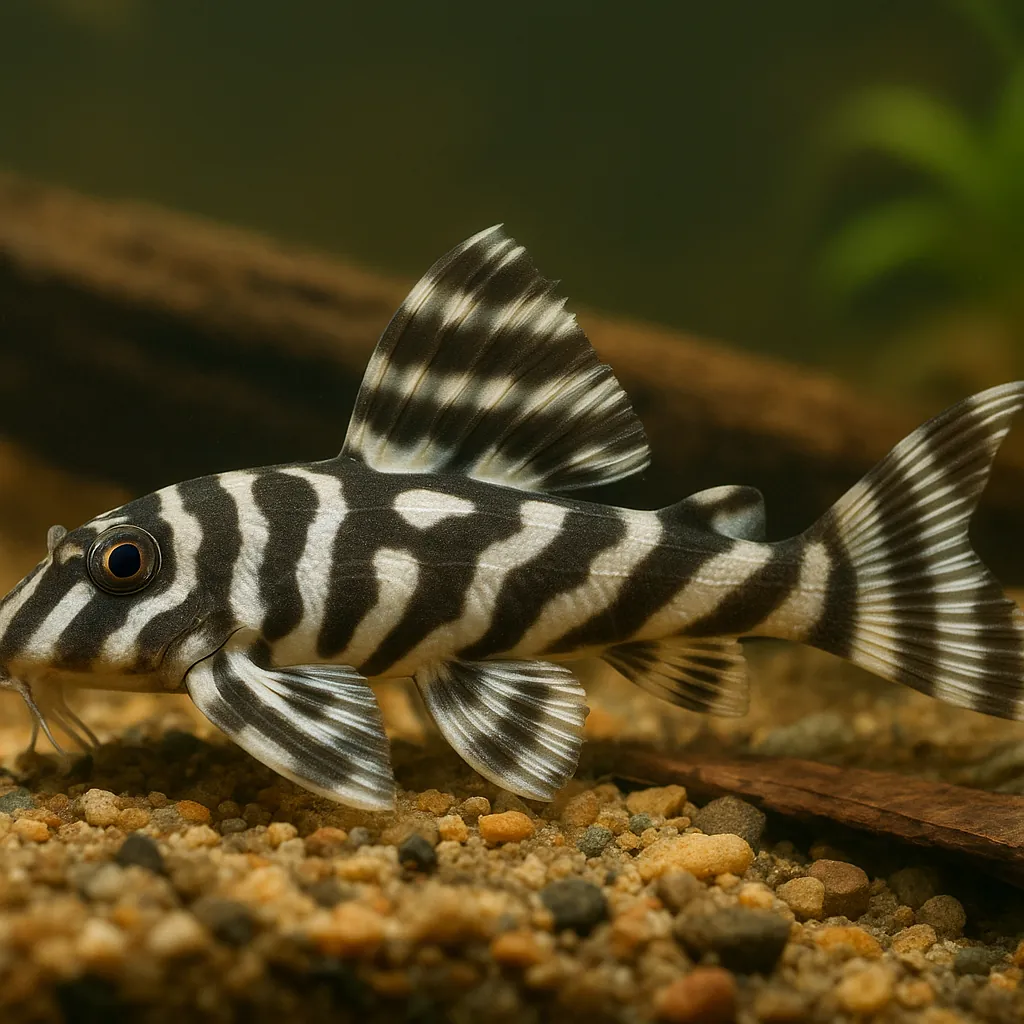
Zebra pleco
Introduction
The Zebra Pleco (Hypancistrus zebra), also known as the Imperial Pleco or L46, is a striking freshwater fish renowned for its bold black and white stripes, reminiscent of a zebra's pattern. This unique appearance, coupled with its relatively small size, makes it a coveted addition among aquarists. However, due to its specific care requirements and higher cost, the Zebra Pleco is best suited for hobbyists with some experience in fishkeeping.
What makes the Zebra Pleco so appealing to aquarists?
Its distinctive black and white striped pattern and peaceful demeanor make it a standout choice for those looking to add a unique and visually striking fish to their aquarium.
Is the Zebra Pleco suitable for beginners?
While its captivating appearance is enticing, the Zebra Pleco's specific care needs and sensitivity to water conditions make it more appropriate for intermediate to advanced fishkeepers.
Care and Environment
Proper care for the Zebra Pleco involves replicating its natural habitat to ensure its health and longevity. Below are key considerations:
What is the minimum tank size for a Zebra Pleco?
A minimum tank size of 113 liters is recommended for a single Zebra Pleco. For groups, a larger tank is advisable to provide ample space and reduce territorial disputes.
What are the ideal water parameters for Zebra Plecos?
Maintaining stable water conditions is crucial. Aim for a temperature range of 26–30°C, a pH between 6.5 and 7.0, and soft to moderately hard water with a hardness of 2–12 dGH.
How should the tank be set up to accommodate Zebra Plecos?
Incorporate plenty of hiding spots using driftwood, caves, and smooth rocks to mimic their natural environment. A substrate of fine sand or smooth gravel is ideal. Ensure moderate to strong water flow and high oxygen levels, as Zebra Plecos thrive in well-oxygenated environments.
What should I feed my Zebra Pleco?
Zebra Plecos are omnivores with a preference for protein-rich foods. Offer high-quality sinking pellets or wafers, supplemented with live or frozen foods like bloodworms and brine shrimp. Occasional blanched vegetables such as zucchini can also be provided.
Are there any specific challenges in keeping Zebra Plecos?
They can be sensitive to water quality and require consistent maintenance. Additionally, males may exhibit territorial behavior, especially during breeding, so providing ample hiding spaces is essential to minimize aggression.
Origin and Habitat
The Zebra Pleco is endemic to the Rio Xingu in Brazil, particularly in areas with fast-flowing, well-oxygenated waters. These regions are characterized by rocky substrates with minimal vegetation, providing numerous crevices and hiding spots. The construction of the Belo Monte Dam has significantly impacted their natural habitat, leading to a decline in wild populations.
Where is the Zebra Pleco naturally found?
It is native to the Rio Xingu in Brazil, inhabiting fast-flowing sections of the river with rocky substrates.
How has human activity affected the Zebra Pleco's habitat?
The construction of the Belo Monte Dam has reduced water flow in the Rio Xingu, threatening the natural habitat and contributing to the species' endangered status.
Temperament and Compatibility
Zebra Plecos are generally peaceful and shy, making them suitable for community tanks with other non-aggressive species. However, males can become territorial, especially during breeding periods. To minimize aggression, it's advisable to maintain a higher ratio of females to males and provide ample hiding spaces.
Can Zebra Plecos be kept with other fish?
Yes, they can coexist with small, peaceful fish such as tetras and rasboras. Avoid housing them with aggressive or significantly larger species.
Do Zebra Plecos need to be kept in groups?
While they can be kept singly, they often thrive in groups. Ensure the tank is spacious enough to accommodate multiple individuals without causing territorial disputes.
Interesting Facts
The Zebra Pleco was first exported from Brazil in 1987 and quickly became a prized species among aquarists due to its unique appearance. Despite its popularity, the Brazilian government has banned its export to protect wild populations. In captivity, males are known to guard eggs diligently until they hatch, showcasing their strong parental instincts.
Why is the Zebra Pleco considered endangered?
Habitat destruction, particularly due to dam construction, has led to a significant decline in their natural populations, resulting in their classification as critically endangered.
How do Zebra Plecos reproduce in captivity?
Breeding involves the male trapping the female in a cave where she lays eggs. The male then fertilizes and guards the eggs until they hatch, a process that can take several days.
Sources
All information in this article has been gathered from the following reputable sources:
Overview
Recommended Tank Size 52.8 Gallons (for groups of 4 or more) |
Minimum Group Size 1 |
Minimum Tank Volume 29.9 Gallons |
Maximum Adult Length 3.9 inches |
Average Adult Length 3.1 inches |
Shoaling (6+ required) No |
Preferred Water Type Freshwater, soft, slightly acidic |
Temperature Range (°C) 26–30 |
pH Range 6.5–7.0 |
Water Hardness (dGH) 2–12 |
Typical Lifespan (years) 10 years |